Beneath Buda Castle, the Hospital in the Rock, Sziklakórház in Hungarian, offers a unique glimpse into Budapest’s history between World War II and the Cold War. The facility served over time from a military hospital to a nuclear bunker. Today, the Hospital in the Rock Nuclear Bunker Museum is an incredible museum showcasing its significant medical heritage and wartime experiences.
Table of Contents
What’s the Hospital in the Rock Nuclear Bunker Museum?
The Hospital in the Rock Nuclear Bunker Museum, beneath Buda Castle, has a fascinating and complex history. Originally constructed during World War II to treat wounded soldiers, it’s also part of an extensive cave and tunnel system carved into the limestone rock beneath Budapest.
PLAN YOUR TRIP TO BUDAPEST
Unlock the best of Budapest with the Budapest Card and enjoy free public transportation, access to the best museums, and relaxation at the famous Lukács Thermal Bath. For more info, read my review of the Budapest Card.
The best way to stay connected in Hungary is with a Holafly eSim, saving real money on data coverage. Finally, ensure your travels are worry-free by getting Heymondo travel insurance for essential peace of mind.
Over the decades, this subterranean space has served multiple purposes, including an air raid shelter, a nuclear bunker, and even a vaccine production institute.
Since 2008, it has been transformed into a museum, and the number of exhibitions has increased over the years. Today, you can only visit the Hospital in the Rock with a guided tour, and I can assure you it is truly fascinating. Before visiting this site, I had explored many bunkers and underground hospitals, but almost none were as large as this one in Budapest!
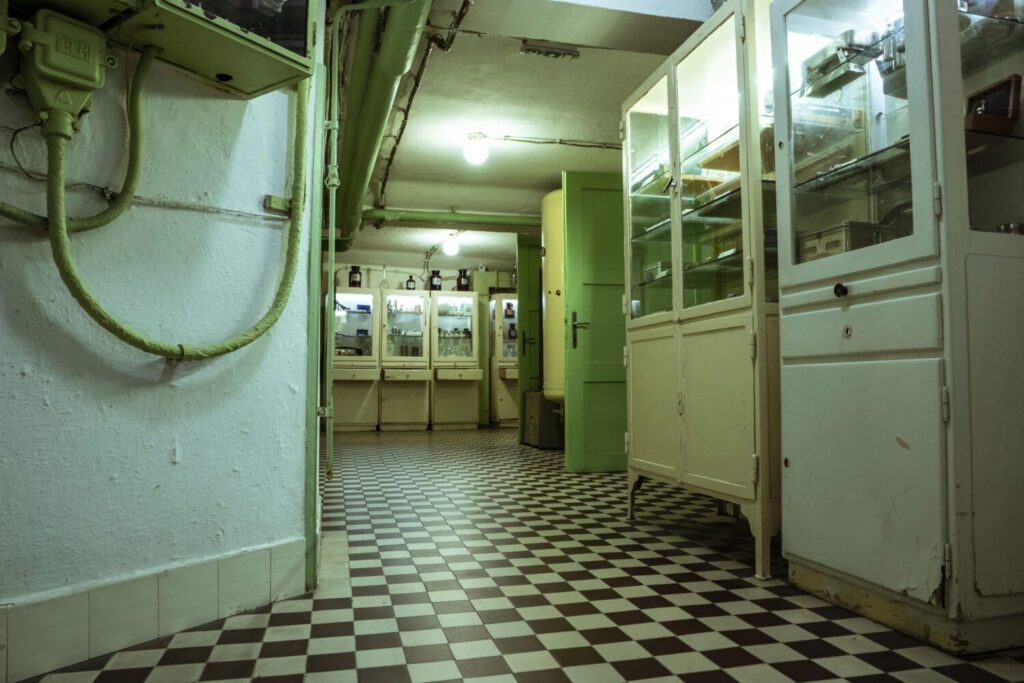
The History of the Hospital in the Rock Nuclear Bunker
The Hospital in the Rock was built in a natural cave system under Castle Hill, formed by spring water after the glacial period. For centuries, the local population utilized this 10-kilometre-long cave network, adapting it for various purposes, from storage to defence.
During World War II, Budapest transformed these caves into shelters, marking the beginning of the intriguing history of the Hospital in the Rock.
Air Shelter Under The Buda Castle
After the outbreak of World War II in 1939, most of the caves served as refuges. The first room constructed in the cave system was an Air Raid Alarm Control Centre, where the army monitored the air raid sirens in the castle area from 1937 to 1945.
While air defence is responsible for securing the airspace, it was decided to expand the area surrounding the existing Air Raid Alarm Control Centre by developing a first-aid post.
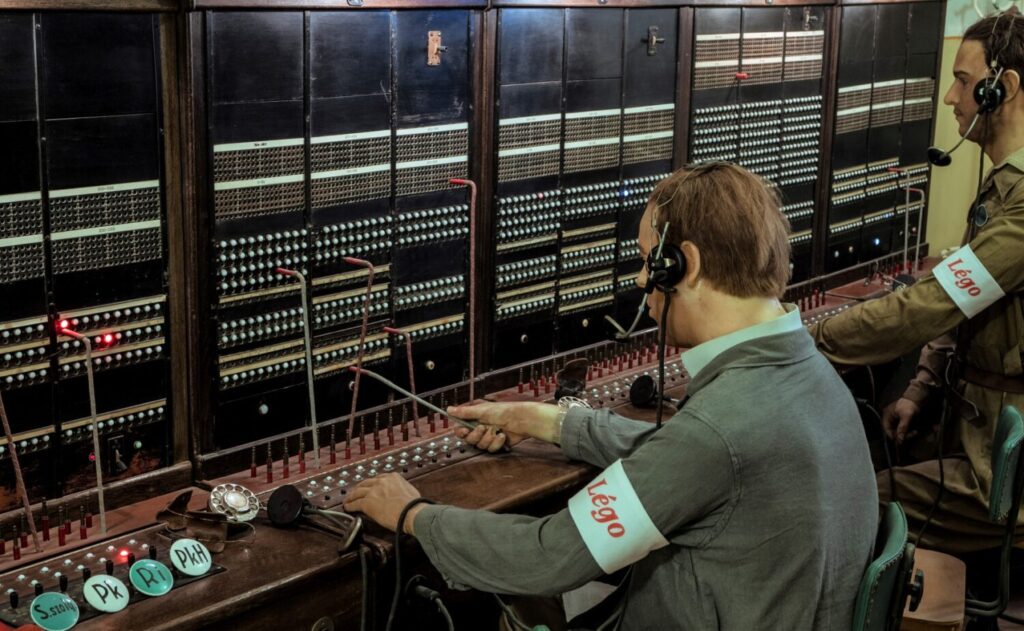
Hospital in the Rock
The Minister of the War Department and the Mayor of Budapest then ordered the construction of the Hospital in the Rock, which was built based on existing tunnels in the cave system.
The construction took place between 1941 and 1943. Wards were created from the caverns, and corridors developed from the passageways. Eventually, the hospital included three wards and a modern operating theatre, which you can see during your guided tour.
Following the American air raids in May 1944, medical staff used the hospital more intensively. They utilized the operating theatre for emergency treatments and welcomed many civilians injured in the aerial attacks.
The Hospital in the Rock During the Siege of Budapest
During the siege of Budapest from 1944 to 1945, the city experienced a 50-day encirclement by Soviet and Romanian forces near the end of World War II. In this challenging environment, the hospital operated beyond its capacity, thanks to the bravery of doctors and healthcare workers.
With all 94 beds continuously occupied, bunk beds were pushed together, accommodating three patients per bed at each level. Additional patients were laid out on stretchers on the floor, as the tour guide will explain during your visit.
The death rate during this period was extremely high due to the elevated risk of infection and a shortage of medical supplies and clean water. Both civilians and soldiers received treatment in the hospital, with a separate ward designated for women.
Fortunately, the hospital had its own generators, ensuring a consistent electricity supply. This capability allowed X-rays to work, which was no longer possible in aboveground hospitals.
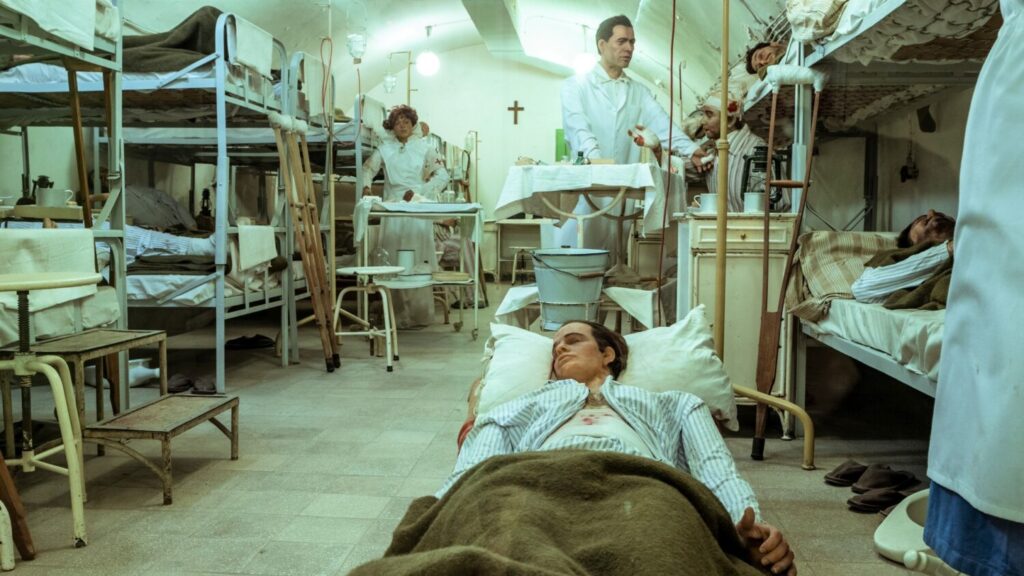
After WWII: Vaccine-Producing Institute
During the guided tour, the guide explains that most of the equipment was removed after World War II. The medical instruments you see today largely came from donations.
Following the war, in fact, the hospital was rented out to a pharmaceutical institute to produce a vaccine against typhus, which became widespread after WWII. For this reason, you can find plush-virus souvenirs in the Hospital in the Rock’s shop.
During the Cold War: Hospital and Nuclear Bunker
In the 1950s, the hospital became a top-secret institution in response to the threats posed by the Cold War. A new ward was built, and the facility was re-equipped for its new purpose.
Between 1958 and 1962, the Hospital in the Rock was converted into a nuclear bunker. However, the guide explained that it wasn’t deep or strong enough to withstand a nuclear attack today, which is far more powerful than the bombs used in World War II.
However, a new ventilation system was installed, with special gas filters and a water supply from the River Danube. The core of these systems consists of two diesel engines and an attached generator, both of which are still operational today, providing filtered air for visitors.
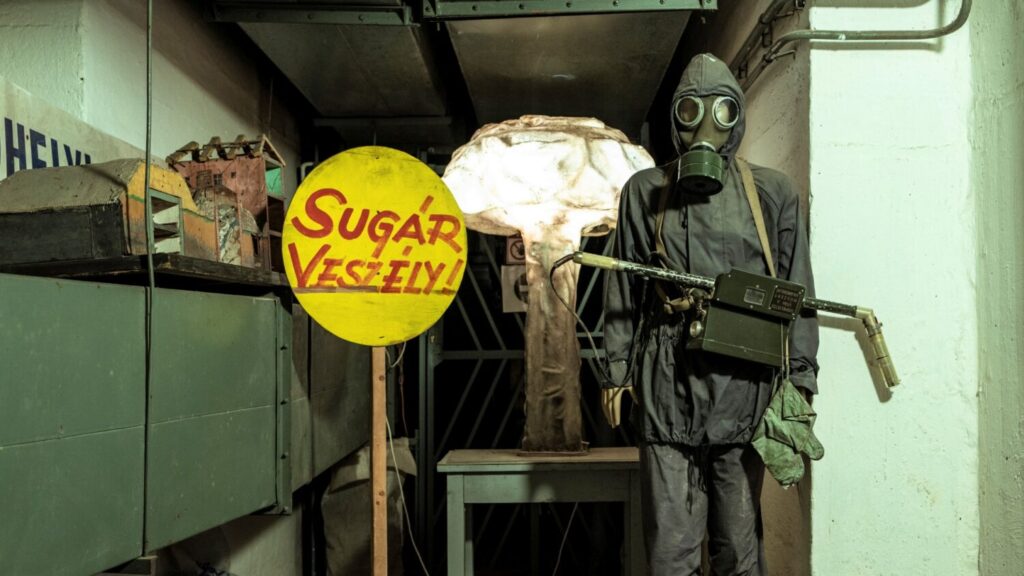
What to Expect on the Hospital in the the Rock Nuclear Bunker Museum Tour
The visit to the Hospital in the Rock Nuclear Bunker Museum is quite fascinating. As mentioned earlier, I had already visited many bunkers and underground hospitals before going to the Sziklakórház, but none were as big.
Doctors and wounded soldiers dummies
The exhibit features dummies in almost every room, mimicking scenes from when the hospital was operating. They are mostly wounded soldiers, but there are also some doctors and nurses.
I’m not usually a fan of mannequins in museum exhibits, but here, they are relatively acceptable and not too weird (I’ve seen worse). Plus, the underground corridors are so intriguing that you tend to overlook the silly expressions of the dummies.
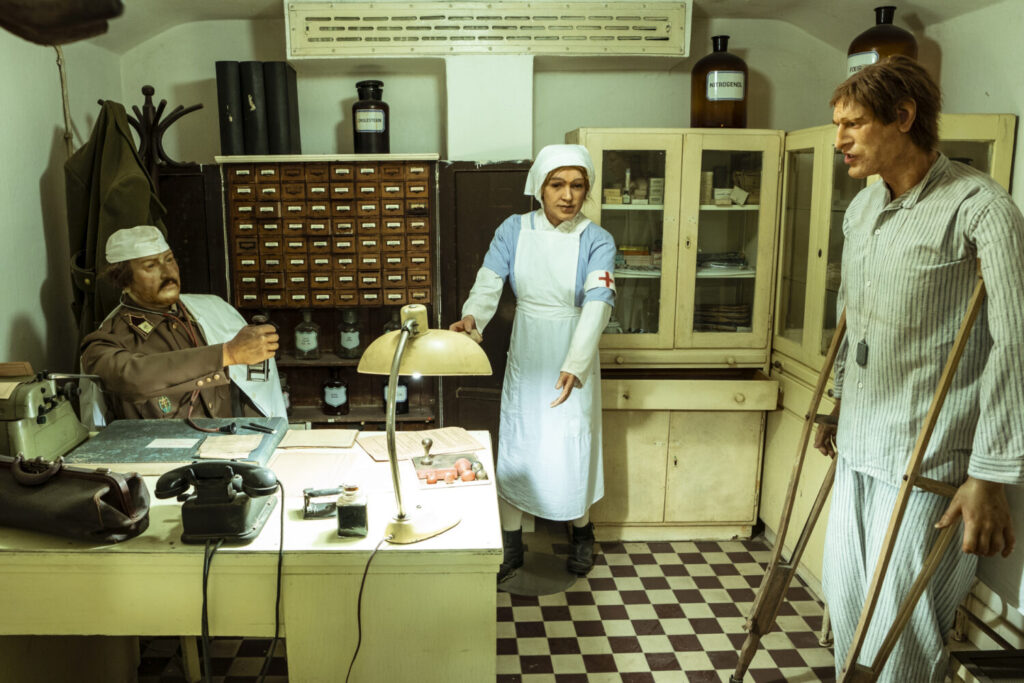
Hungarian Helicopter
Another point of interest is the stunning helicopter PZL Mi-2, with callsign HA-BGN. It was taken apart and reassembled in an underground room of the museum.
Honestly, the idea of creating an underground room to explain the war situation above ground doesn’t add much to the visit’s itinerary. However, seeing a whole helicopter down there it’s really amazing, and as an aviation enthusiast, I totally appreciate it.
From the Atomic Threat to the Real Atomic Blast
Lastly, the final rooms exhibit artefacts from Hiroshima and Nagasaki. The visit ends with a display of origami cranes that tell the story of Sadako Sasaki, the Japanese little girl who became ill from the radiation from the atomic bomb and folded more than one thousand origami cranes before her death.
The connection between the atomic threat, the Cold War, the bunker, and the actual dropping of the atomic bombs on Japan at the end of World War II is profound and moving. Like all war museums, it serves as a reminder to strive for peace.
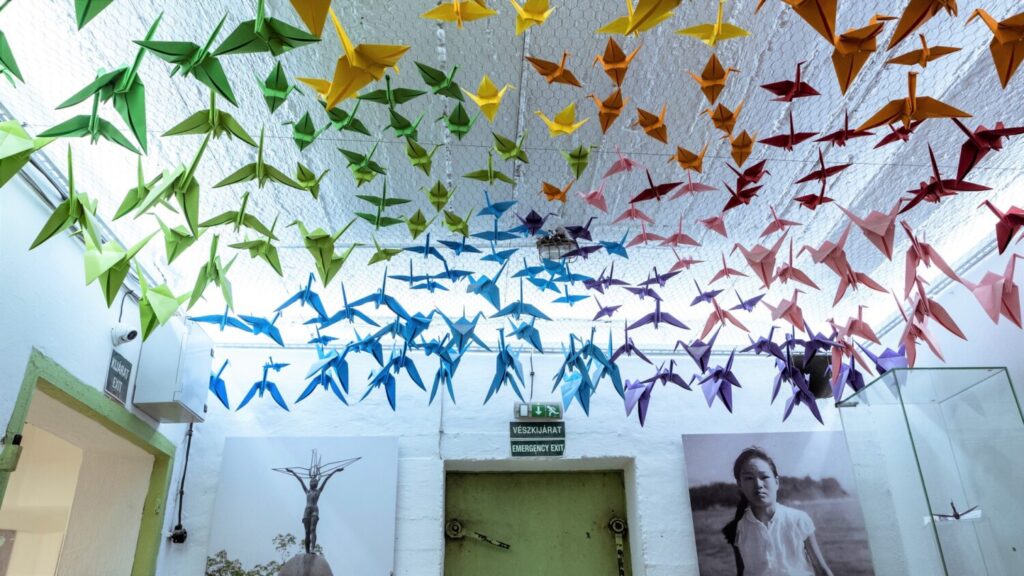
How to Plan Your Visit to the Hospital in the Rock Nuclear Bunker Museum
You can visit the Hospital in the Rock Nuclear Bunker Museum only through a guided tour, included in the ticket price. The standard guided tour lasts 60 minutes and allows you to explore all the museum exhibitions with a guide.
Inside the hospital, the temperature is between 15-18°C, so you should dress accordingly. You can’t take photos, videos or audio recordings inside the Hospital in the Rock Nuclear Bunker Museum, so the pictures shown here are all from the official press kit, except for the one on the outside.
Hospital in the Rock Nuclear Bunker Museum with Children
I visited the Hospital in the Rock Nuclear Bunker Museum alone because I saw on their website that young children under 6 are not allowed to enter due to the disturbing and shocking design of the exhibition. Also, it isn’t recommended for children under 12, although they can visit with the approval and supervision of a parent or guardian.
In my opinion, there was nothing particularly shocking in the museum. On the contrary, I believe it would have been very interesting for my son. We have visited several bunkers in Tirana, and I can assure you that Bunk’Art 1 and Bunk’Art 2 are definitely more disturbing than the Sziklakórház in Budapest. Furthermore, the exhibits of the Underground Hospital at Dover Castle present more daunting scenarios.
During all these visits, my son showed interest and was not scared at all. I believe you can show children almost anything as long as you provide them with context and information about it. Of course, if a child isn’t particularly sensitive, and that’s something only a parent would know best. Nevertheless, as I mentioned, visiting is still not possible for children under 6.
Opening Hours
The Hospital in the Rock Nuclear Bunker Museum is open daily from 10:00 am to 7:00 pm. The musuem is closed only on January 1st, November 1st, and December 24th and 25th, as well as December 31st.
Admission Fee
The Hospital in the Rock Nuclear Bunker Museum charges €30 per adult, or 9,500 Hungarian Forints per each person. There are discounts for Budapest Card holders, over 65, students, kids, and teachers.
Just remember that the museum is cashless, so you can pay only with credit card or debit card, in euros or forints. Alternatively, you can buy online tickets and reserve your place for the tour in advance. I recommend this option because the Hospital in the Rock is a very popular destination in Budapest, with limited places available per tour.
How to Reach the Hospital in the Rock
The Hospital in the Rock Nuclear Bunker Museum is located on Buda Hill, not far from the Buda Castle. You can easily reach the Hospital in the Rock using public transportation.
From the center of Budapest, I recommend to take bus numbers 5, 105, or 210. To find the best route to the museum from your location, use Google Maps and, if you need more info about public transport you can read more on how to get around Budapest on the blog.
The museum is approximately a 10-minute walk from the bus stop. Please keep in mind that you are on Buda Hill, so depending on which bus stop you use, the walking route may involve some uphill sections or stairs.
If you have difficulty walking uphill, you might prefer to take a taxi instead of the bus. Regardless of the route you choose, the internal pathway to the Hospital in the Rock Nuclear Bunker Museum is straightforward and accessible for everyone.
Sziklakórház (Hospital in the Rock)
Budapest Toth Arpad setany 26 1014
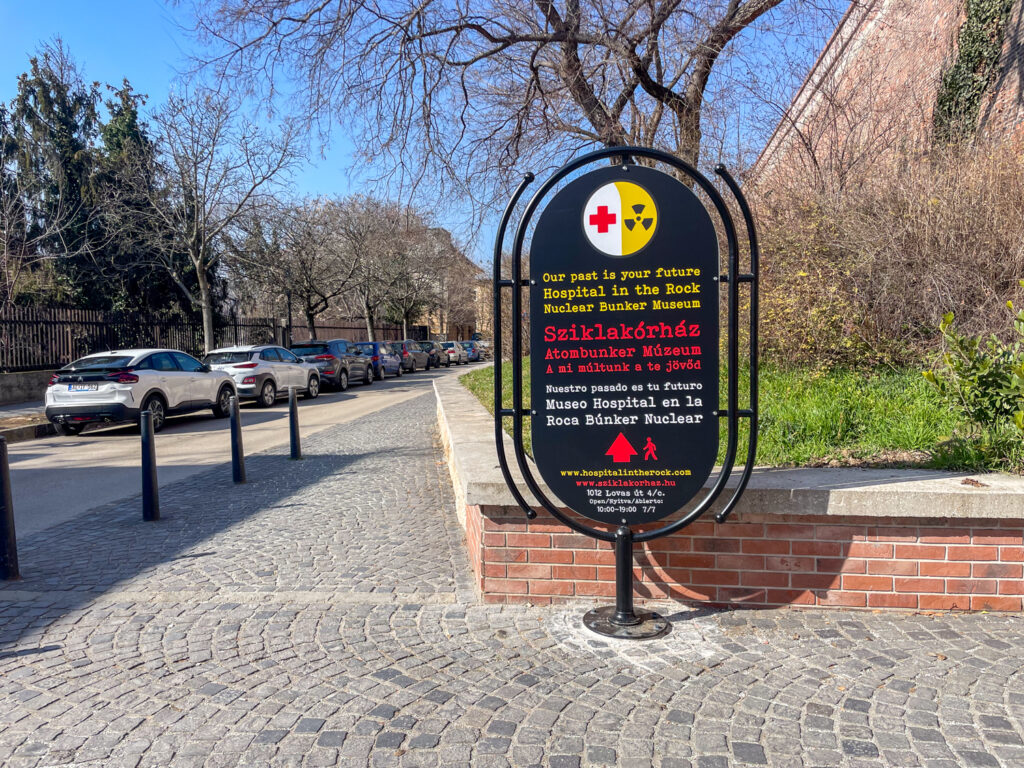
Where to stay in Budapest
Budapest offers a wide range of beautiful hotels to choose from. Hampton By Hilton Budapest City Centre (here my review) is located in the heart of Budapest, just 600 metres from St. Stephen’s Basilica. They offer a delicious breakfast and have a restaurant and a bar on-site. For those looking for a hotel with unique and stunning decor, Stories Boutique Hotel is a 4-star property situated 500 meters away from the Hungarian State Opera. They have a restaurant on-site that serves à la carte, a continental or vegetarian breakfast. If you prefer an aparthotel, Zoya Luxury Residence is an excellent option with units with a coffee machine, a dishwasher, a microwave and parking space.
Final Thoughts about the Hospital in the Rock
The Hospital in the Rock is a fascinating site that showcases a unique blend of medical history and underground facilities during Budapest’s wartime and Cold War periods. I loved it, and I totally recommend visiting when in Budapest. Now, it’s your turn to share your thoughts and experiences from your visit in the comments!
